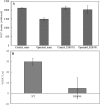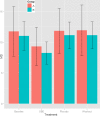Ginkgo biloba: an adjuvant therapy for progressive normal and high tension glaucoma
- PMID: 22355250
- PMCID: PMC3283204
Ginkgo biloba: an adjuvant therapy for progressive normal and high tension glaucoma
Abstract
Gingko biloba has been used for hundreds of years to treat various disorders such as asthma, vertigo, fatigue and, tinnitus or circulatory problems. Two of the main extracts are EGb761 and LI 1370. Most pharmacological, toxicological and clinical studies have focused on the neuroprotective value of these two main extracts. Neuroprotection is a rapidly expanding area of research. This area is of particular interest due to the fact that it represents a new avenue of therapy for a frustrating disease that may progress despite optimal treatment. One such disease is glaucoma.Glaucoma leads to the loss of retinal ganglion cells and their axons but also to tissue remodelling which involves both the optic nerve head and the retina. In the retina the astrocytes get activated. In addition, the optic nerve gets thinner and the cells of the lateral geniculate ganglion disappear partially. On average, ocular blood flow (OBF) is reduced in glaucoma patients in various tissues of the eye. Increased intraocular pressure (IOP) is a major risk factor for glaucomatous damage. Nevertheless, there is little doubt that other risk factors besides IOP are involved. One such risk factor is a primary vascular dysregulation (PVD) occurring in patients with a disturbed autoregulation, another risk factor is oxidative stress.
Figures




Similar articles
-
New insights in the pathogenesis and treatment of normal tension glaucoma.Curr Opin Pharmacol. 2013 Feb;13(1):43-9. doi: 10.1016/j.coph.2012.10.001. Epub 2012 Oct 22. Curr Opin Pharmacol. 2013. PMID: 23092679 Review.
-
[Value of non-IOP lowering therapy for glaucoma].Klin Monbl Augenheilkd. 2013 Feb;230(2):114-9. doi: 10.1055/s-0032-1327825. Epub 2013 Feb 21. Klin Monbl Augenheilkd. 2013. PMID: 23430676 Review. German.
-
Short-term effects of Ginkgo biloba extract on peripapillary retinal blood flow in normal tension glaucoma.Korean J Ophthalmol. 2011 Oct;25(5):323-8. doi: 10.3341/kjo.2011.25.5.323. Epub 2011 Sep 20. Korean J Ophthalmol. 2011. PMID: 21976939 Free PMC article. Clinical Trial.
-
Ginkgo Biloba Extract in Ophthalmic and Systemic Disease, With a Focus on Normal-Tension Glaucoma.Asia Pac J Ophthalmol (Phila). 2020 May-Jun;9(3):215-225. doi: 10.1097/APO.0000000000000279. Asia Pac J Ophthalmol (Phila). 2020. PMID: 32282348 Free PMC article. Review.
-
Ginkgo biloba and its potential role in glaucoma.Curr Opin Ophthalmol. 2018 Mar;29(2):116-120. doi: 10.1097/ICU.0000000000000459. Curr Opin Ophthalmol. 2018. PMID: 29206653 Review.
Cited by
-
Cardiovascular Effects of Herbal Products and Their Interaction with Antihypertensive Drugs-Comprehensive Review.Int J Mol Sci. 2024 Jun 9;25(12):6388. doi: 10.3390/ijms25126388. Int J Mol Sci. 2024. PMID: 38928095 Free PMC article. Review.
-
The potential for mitochondrial therapeutics in the treatment of primary open-angle glaucoma: a review.Front Physiol. 2023 Aug 2;14:1184060. doi: 10.3389/fphys.2023.1184060. eCollection 2023. Front Physiol. 2023. PMID: 37601627 Free PMC article. Review.
-
Diet, Oxidative Stress, and Blood Serum Nutrients in Various Types of Glaucoma: A Systematic Review.Nutrients. 2022 Mar 29;14(7):1421. doi: 10.3390/nu14071421. Nutrients. 2022. PMID: 35406033 Free PMC article.
-
Glaucoma and Antioxidants: Review and Update.Antioxidants (Basel). 2020 Oct 22;9(11):1031. doi: 10.3390/antiox9111031. Antioxidants (Basel). 2020. PMID: 33105786 Free PMC article. Review.
-
Nanoparticles for the treatment of glaucoma-associated neuroinflammation.Eye Vis (Lond). 2022 Jul 2;9(1):26. doi: 10.1186/s40662-022-00298-y. Eye Vis (Lond). 2022. PMID: 35778750 Free PMC article. Review.
References
-
- Li S, Tang D, Xue Z, Zhang Z, Sun X, Liu Y, Dong H, Yin X, Zhang Z. Biphasic effect of EGb761 on simulated ischemia-induced rat BMSC survival in vitro and in vivo. Life Sci. 2011;88:853–63. - PubMed
-
- Janssen IM, Sturtz S, Skipka G, Zentner A, Garrido MV, Busse R. Ginkgo biloba in Alzheimer's disease: a systematic review. Wien Med Wochenschr. 2010;160:539–46. - PubMed
-
- de Lima KC, Schilichting CL, Junior LA, da Silva FM, Benetoli A, Milani H. The Ginkgo biloba extract, EGb 761, fails to reduce brain infarct size in rats after transient, middle cerebral artery occlusion in conditions of unprevented, ischemia-induced fever. Phytother Res. 2006;20:438–43. - PubMed
Publication types
MeSH terms
Substances
LinkOut - more resources
Full Text Sources
Medical
